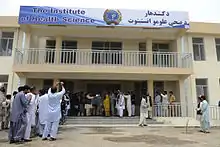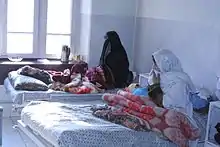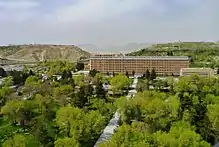Healthcare in Afghanistan
The decades of war has destroyed Afghanistan's already-poor health care system. Most Afghan medical professionals immigrated to other countries by 1992, and all medical training programs ceased. In 2003, there were 11 physicians and 18 nurses per 100,000 population, and the per capita health expenditure was $28 US dollars. The nation had one medical facility for every 27,000 people in 2004, and some centers were responsible for as many as 300,000 people. An estimated one-quarter of the population had no access to health care. The international organizations provided a large share of medical care. The drought of 1999–2002 exacerbated these conditions.
Between 2014 and 2019 420 new health facilities were established including the first neurosurgery hospital.
Hospitals
There are over 100 government-run and private or internationally-administered hospitals in Afghanistan. The most advanced medical treatments are available in Kabul. The French Medical Institute for Children and Indira Gandhi Children's Hospital in Kabul are the leading children's hospitals in the country. The Daoud Khan Military Hospital and the Jamhuriat Hospital are two of the most popular hospitals in the country. The Jinnah Hospital is the second largest hospital in Afghanistan. In spite of all this, many Afghans still travel to Pakistan, India, Iran, Turkey and other countries for advanced treatment.
Maiwand Teaching Hospital was established in the 1960s, designed to treat between 300-400 patients a day, but in 2019 there are often 1,000 patients in a day.
History

It was reported in 2006 that an estimated 800,000 Afghans are disabled.[1] Infant, child, and maternal mortality rates in Afghanistan reached the highest in the world, by some estimates as high as 275 per 1,000. In rural areas, one in six children die before reaching age five. This is because of poor sanitation and insufficient potable water supply, infectious and parasitic diseases such as malaria and diarrhea are very common. Malnutrition and poor nutrition also are pervasive.

Fees
User fees have been a major deterrent to accessing health care. Various interventions have been devised to improve uptake of health care services, including the distribution of waiver cards to very poor and female-headed households[2] and the introduction of community-based health insurance.[3]
Following the national user fee ban in 2008, a pilot study conducted by the Future Health Systems consortium found a 400% increase in utilization of services that had previously charged fees for services and medicine.[4] The government's strategy to collaborate with non-governmental organisations[5] has led to higher primary health outcomes among the poor,[6] with relatively high levels of perceived health care quality reported by clients in a recent study of primary care services.[7]
Effects of war
The physical and psychological effects of war have substantially increased the need for medical care. A number of new hospitals have been established, with the most advanced treatments being available in Kabul. The French Medical Institute for Children and Indira Gandhi Childrens Hospital in Kabul are the leading children's hospitals in the country. Some of the other main hospitals in Kabul include the 350-bed Jamhuriat Hospital, the Sardar Mohammad Daud Khan Hospital,[8] and the Jinnah Hospital, which is under construction. There are also a number of military-controlled hospitals in different regions of the country. A new 350-bed hospital was constructed in 2017 in the southern Afghan city of Kandahar.[9]
In the first quarter of 2019 there were 34 reported attacks on healthcare facilities, at least 87 were closed. At least nine workers and patients were killed.
Pharmaceuticals
There are media reports of low-quality, fake or expired Pakistani and Iranian drugs. As many patients cannot pay for their prescriptions doctors may give them expired medicines.
Staffing
Average pay for a doctor in a government hospital is between 12,000-15,000 Afghanis ($151-$189) a month. Most doctors supplement this by working after-hours at private clinics.
Maternal and child health care

Afghanistan made significant improvement in the last decade to its maternal and child health care. According to United States Agency for International Development (USAID), Afghanistan's mortality rate has decreased by about 25% since 2003. It was reported in 2006 that nearly 60% of the population lives within two hours walking distance of the nearest health facility.[10]
The maternal mortality rate is currently 396 deaths/100,000 live births and its infant mortality rate is 66[11] to 112.8 deaths in every 1,000 live births.[12] The Ministry of Public Health wants to further improve these higher rates by making them normal.
The country has more than 3,000 midwives, with an additional 300 to 400 being trained each year.[13] According to Sima Ayubi, a maternity doctor in Kabul who advocates hospital births, explains: "Now pregnant women have more information about health. This mortality rate is still a problem. There's just a decrease. The problem is not completely eliminated or under control."[13]
According to a 2012 report by Save the Children, improved healthcare and the rise of females attending school have made Afghanistan climb up from its position as the worst place on earth to be a mother. "More mothers are surviving and fewer children are dying and this is something we need to be celebrating," said Rachel Maranto, Advocacy and Mobilisation senior Manager at Save the Children in Kabul.
Treatment in other countries
Afghans spend an estimated $300 million a year on medical treatment abroad, mostly in Pakistan, India and Turkey.[14]
References
- Afghanistan country profile. Library of Congress Federal Research Division (May 2006). This article incorporates text from this source, which is in the public domain.
- Steinhardt, Laura; David Peters (2010). "Targeting accuracy and impact of a community-identified waiver card scheme for primary care user fees in Afghanistan". International Journal for Equity in Health. 9 (28): 28. doi:10.1186/1475-9276-9-28. PMC 3004906. PMID 21114851. Retrieved 18 May 2012.
- Rao, K; et al. (27 May 2009). "An Experiment with Community Health Funds in Afghanistan". Health Policy and Planning. Retrieved 26 May 2012.
- Steinhardt, Laura; Iqbal Aman; Iqbalshah Pakzad; Binay Kumar; Lakhwinder Singh; David Peters (2011). "Removing user fees for basic health services: a pilot study and national roll-out in Afghanistan". Health Policy and Planning. 26 (Suppl 2): ii92–ii103. doi:10.1093/heapol/czr069. PMC 3247786. PMID 22027924. Retrieved 18 May 2012.
- Arur, A; et al. (22 October 2009). "Contracting for Health and Curative Care Use in Afghanistan Between 2004 and 2005". Health Policy and Planning. Retrieved 26 May 2012.
- Hansen, Peter; et al. (2008). "Determinants of Primary Care Service Quality in Afghanistan". Int J Qual Health Care. 20 (6): 375–383. doi:10.1093/intqhc/mzn039. PMID 18799469. Retrieved 26 May 2012.
- Hansen, Peter; et al. (2008). "Client Perceptions of the Quality of Primary Care Services in Afghanistan". Int J Qual Health Care. 20 (6): 384–391. doi:10.1093/intqhc/mzn040. PMID 18799468. Retrieved 26 May 2012.
- Rivera, Ray; Sahak, Sharifullah (21 May 2011). "Blast Hits Military Hospital in Afghan Capital". The New York Times.
- https://www.pajhwok.com/en/node/486178
- "Health". United States Agency for International Development (USAID). www.usaid.gov. Retrieved October 20, 2010.
- "Afghanistan". UNESCO. Retrieved 2017-05-20.
- "Afghanistan". The World Factbook. www.cia.gov. Retrieved 2017-05-20.
- Peter, Tom A. (17 December 2011). "Childbirth and maternal health improve in Afghanistan". Christian Science Monitor. Archived from the original on 31 December 2013. Retrieved 12 January 2012.
- "Years of war and poverty take toll on Afghanistan's healthcare". Aljazeera. 25 May 2019. Retrieved 9 July 2019.
